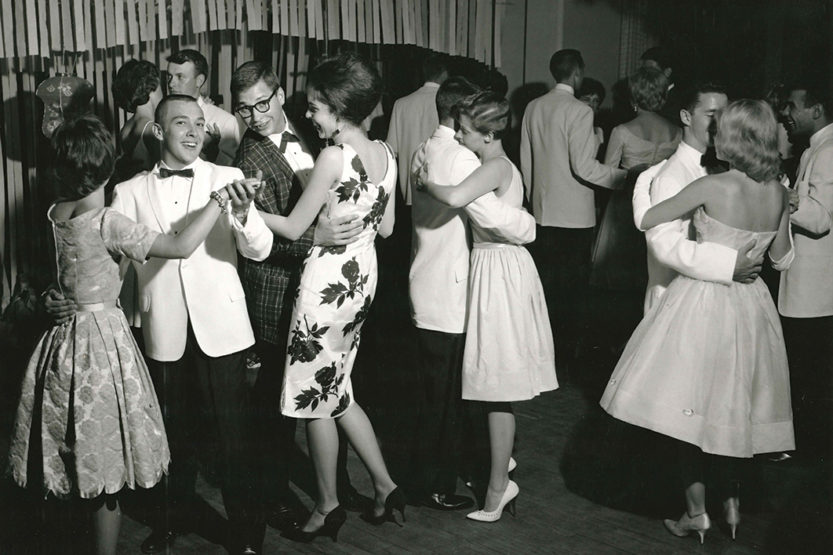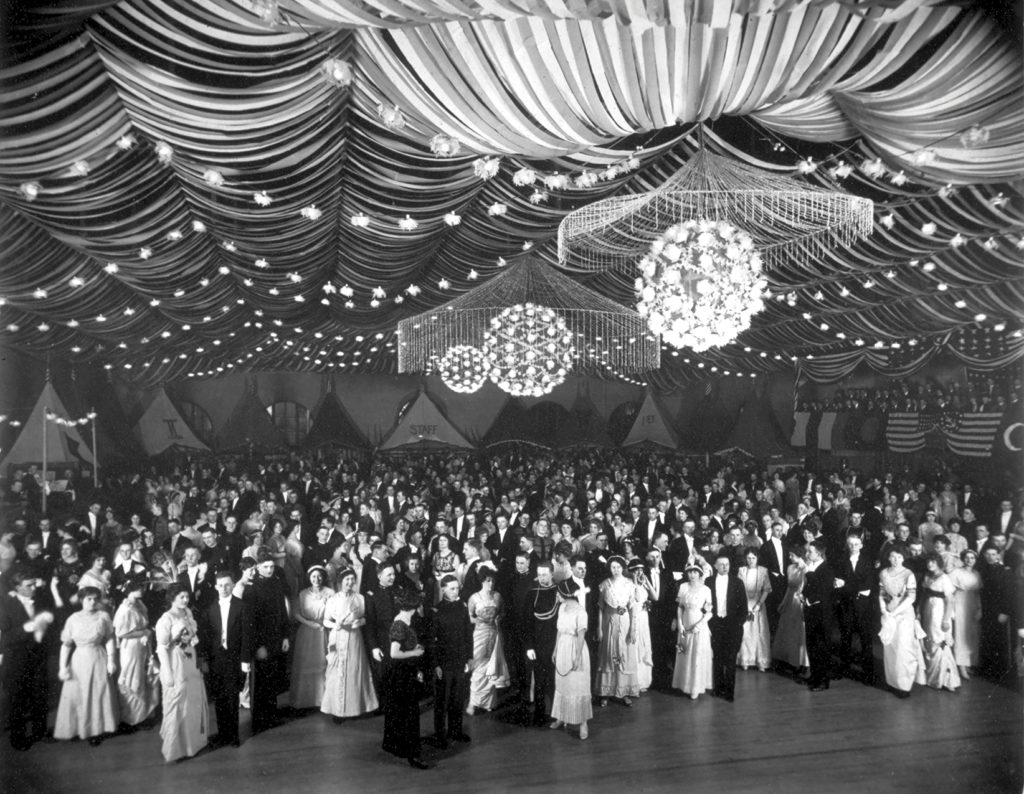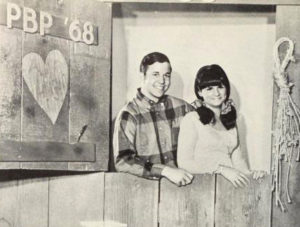Memory Lane: Dance Fever
 Dances often featured big-name musicians such as Benny Goodman and Tommy Dorsey, and ranged from those organized by class—e.g., the Junior Prom and the Senior Ball (which had to be held on two nights to accommodate the nearly 1,000 couples who came)—to those based on academic programs—e.g., the Military Ball (ROTC), St. Pat’s (Engineering) and Plowboy Prom (ACES). (Image courtesy of UI Archives)
Dances often featured big-name musicians such as Benny Goodman and Tommy Dorsey, and ranged from those organized by class—e.g., the Junior Prom and the Senior Ball (which had to be held on two nights to accommodate the nearly 1,000 couples who came)—to those based on academic programs—e.g., the Military Ball (ROTC), St. Pat’s (Engineering) and Plowboy Prom (ACES). (Image courtesy of UI Archives) Louise Kenyon Molitor, ’33, never forgot the enchanting spring night that she danced on the roof of Robeson’s department store, five stories above the downtown Champaign streets. She, her date and dozens of other couples—the men decked out in white tuxedos and the women in long formal gowns—glided across the glass-like surface of the dance floor, swaying to the “wah-wah” strains of jazz trumpeter Clyde McCoy’s Sugar Blues.
“I thought, ‘Oh, isn’t this wonderful,’” Molitor recalled in 2001. “The stars are all out, you know, and the blossoms fragrant. It was really something.”
Between the 1910s and 1940s, dancing enjoyed its heyday on the Illinois campus, where it was one of the most popular undergraduate extracurricular pursuits. “I mean, everybody danced,” Beth Olwin Dawson, ’33, told an interviewer. “Every Friday and Saturday night were dance nights.” During a single May weekend in 1926, a whopping 46 dances were held on campus.
According to Kathryn Hansen, ’34, the Robeson roof stood at “the apex” of the campus dancing scene during the pre-World War II era. Then there was Bradley Hall on Wright Street, which wasn’t “quite as choice, but it would do in a pinch,” she maintained. Other area dance hotspots included College Hall on Fourth Street and the Park, above Prehn’s, on Green Street. The Park must have violated a building code or two: “its floor would wobble,” Katharin Carr, ’31 LAS, recalled.
Huff Gym and the Gymnasium Annex served as the venues for the University’s major dances of the year—the Freshman Frolic, Sophomore Cotillion, Junior Prom and Senior Ball. These gala affairs often boasted big-name musicians such as Benny Goodman, Tommy Dorsey and Paul Whiteman, and usually attracted large crowds. For a time, the Senior Ball had to be held on two nights at Huff Gym in order to accommodate the nearly 1,000 couples who attended each night.
There also were more exclusive University dances such as the Military Ball for ROTC members, the St. Pat’s Ball for engineers and the Plowboy Prom for Agriculture students. The Plowboy Prom (a.k.a., the Corncob Cotillion and the Barnyard Jamboree) featured countrified couples outfitted in overalls and gingham, and adorned with vegetable corsages and lunch baskets. The Plowboy Prom queen received her crown while sitting on a throne of hay bales.
The Greeks, of course, sponsored dances of their own. In those days, the University permitted chapter houses to hold only three dances each semester—a formal, an informal and a novelty affair. Even so, dances were never in short supply for the Greeks. A member of the Delta Zeta sorority, Florence Hood Miner, ’29, recalled going to Greek dances every Friday and Saturday night. “You went to the movies,” she said, “but the dances were the big thing.”
But dancing wasn’t always a “big thing” at Illinois. The school’s early leaders viewed dancing as immoral and vigorously opposed it. In the 1880s, Regent Selim Peabody warned students that dancing would damage the University’s reputation. Later, when Peabody attempted to break up a class dance being held surreptitiously in the Gym Annex, students turned a fire hose on him and washed him out of the building! As late as the 1910s, the University cracked down on “such doubtful new trippings” as the tango and subsequently banned “all ‘ragging’ and unnatural movements such as wriggling the shoulders, swaying the hips, pumping the arms, flopping the elbows, skipping, hopping, galloping or low fantastic dips.”
Although the dances continued, the golden age of campus dancing came to an end after World War II. Still, the magical era when seemingly everybody danced is preserved in the scrapbook of memory. “If you couldn’t go to a dance on Friday and Saturday night both, it was kind of a lost weekend,” Wanda Spencer Larson, ’38 LAS, remarked in 2001.



